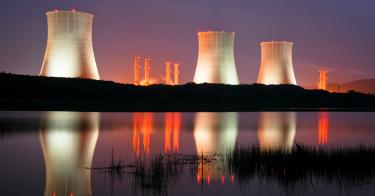President Donald Trump spoke on Thursday about what can be done to help the commercial nuclear power industry as part of Energy Week.
“A complete review of U.S. nuclear energy policy will help us find new ways to revitalize this crucial energy resource,” the president said in remarks at the Department of Energy.
The timing is apt, as the nuclear industry has hit rough times.
Bloomberg New Energy Finance reported earlier this month that over half of nuclear power operators are losing money for a collective loss of roughly $2.9 billion per year. In the past five years, a series of plants have closed or announced closure years before their operating licenses expired.
And yet, the 99 reactors in America offer the reliable and efficient electricity available. Nuclear power provides roughly 20 percent of the electricity Americans use—it takes over 7,500 power plants to cover the other 80 percent.
For all the electricity they produce, nuclear power plants have a small physical footprint. There are virtually zero pollutants. Its benefits have even won over anti-nuclear activists like former Environmental Protection Agency Administrator Carol Browner.
Facing a precarious future, the nuclear industry too often resorts to big government solutions like tax credits and renewable portfolio standards—the thinking being that if renewable energy gets them, why can’t nuclear?
One almost can’t blame them for playing the lobbying game for government handouts.
The wind industry got roughly $34 per megawatt hour in federal subsidies during fiscal year 2013, and the solar industry got roughly $667 per megawatt hour, according to a recent study by the University of Texas-Austin.
But leaders in Washington should know better than to solve one problem by compounding it with another. The nuclear industry’s inability to respond, even with its own “free money” on the table for new nuclear plants, should be a signal to politicians that there are deeper issues plaguing the industry.
There are other things the Trump administration and Congress can do that don’t involve more government handouts. Here’s an abbreviated list of things the Trump administration and Congress could do to get the ball rolling:
- Eliminate all energy subsidies. Federal tax credits for wind and solar have been particularly destructive to energy markets by distorting electricity prices and energy infrastructure investments.
- Encourage states to abandon renewable portfolio standards. States have done damage to their own electricity markets with renewable electricity mandates. It makes no sense to center electricity markets around politically privileged resources rather than qualities like how to get the most reliable, affordable, efficient energy to customers.
- Correct EPA radiation exposure standards. The EPA has for decades mischaracterized the risk posed by very low levels of radiation, which are far lower than justified by a growing body of science and experience. Rightsizing radiation exposure standards would reduce cost drivers in the nuclear industry while also better informing the public.
- Review foreign ownership caps. Vague standards by the Nuclear Regulatory Commission on foreign investment have halted nuclear power projects in places like Texas and Maryland. It’s hard to see why the U.S. wouldn’t want investment from foreign companies like those in France, which is a longtime ally and an industry leader committed to nonproliferation
- Address over-regulation. Over-regulation from the Nuclear Regulatory Commission and the EPA has put U.S. companies and utilities at a disadvantage. A study by the American Action Forum puts annual paperwork costs at $4.2 million per power plant.
- Improve the culture of Nuclear Regulatory Commission. It takes far too long for the commission to process actions that improve nuclear power plants, let alone build new ones. Despite the recent increase in staff and resources, the commission has not become more efficient.
- Reform Nuclear Regulatory Commission fee cost recovery structure. Outside of the nuclear industry, no other electricity provider is required to pay for the budget of its regulator. This quasi-business arrangement does not lead to transparency or incentivize efficient use of resources in the commission, and is a barrier to entry for new companies.
For all the benefits nuclear power plants in America have provided over the past 60 years, the federal government needs to be willing to do what it takes to regulate this industry appropriately, and then let it succeed or fail on its own merits.
This piece originally appeared in The Daily Signal



